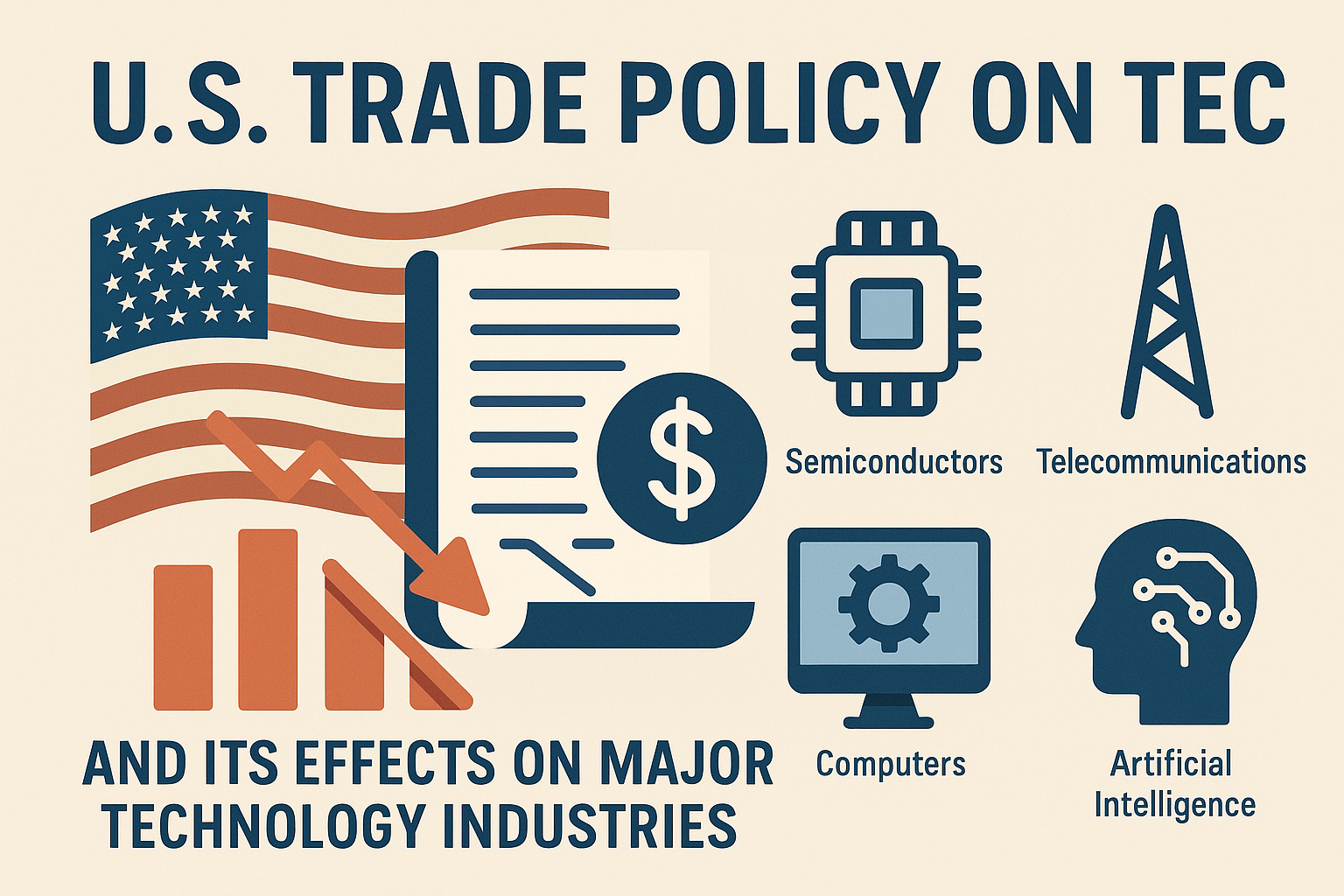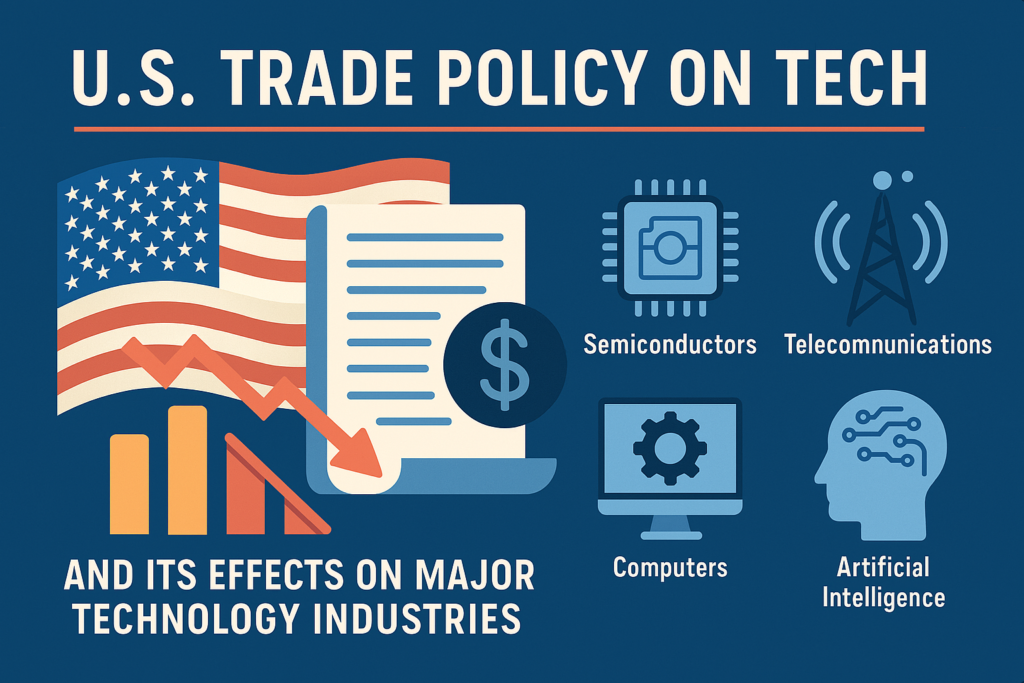
US trade policy on tech and its effects on major technology industries
The U.S. technology region, a foundation of global invention and profitable excrescency, faces unknown expostulations as recent shifts in trade procedure under the Trump administration reshape force progressions, consumer requests, and geopolitical dynamics. From drifting tariffs targeting crucial trading mates to strategic immunity for overcritical diligence like semiconductors, these programs are reconsidering how tech titans operate and survive in a decreasingly fractured global frugality. This composition examines the multifaceted impacts of U.S. trade measures on major technology diligence, involving consumer electronics,e-commerce, semiconductors, and digital services, while probing the thick counteraccusations for invention, public screen, and global competitiveness.

1. Tariffs and the Reshaping of Tech Supply Chains
The Trump administration’s 2025 tariff procedure imposes impositions ranging from 10 to 49 on significances from China, Vietnam, India, and other manufacturing capitals, dismembering the tightly integrated force progressions of companies like Apple, Amazon, and Meta 28. For case, Apple, which manufactures over half of its iPhones in China and India, eyed its stock freight drop by 6 following the advertisement, reflecting investor enterprises over rising product charges and dallied shipments 2. also, Amazon’s third- party business, heavily reliant on Chinese merchandisers, faces logistical backups and advanced freights due to the elimination of the de minimis impunity — a loophole that preliminarily allowed duty- free significances of fragile packages appraised under$ 800 28.
Key impacts carry
- Cost Pressures Companies reliant on overseas manufacturing are scrabbling to talk supplier contracts or absorb tariff- related charges, which could conduct to advanced consumer prices. Goldman Sachs estimates a 35 liability of a U.S. depression within 12 months, incompletely driven by inflationary pressures 2.
- Force Chain Diversification Some enterprises are probing nearshoring to Mexico or Southeast Asia, but this transition is expensive and tardy. Logistics startups like Nuvocargo, which facilitatescross-border freight between Mexico and the U.S., report surging demand for their services, pressing the chaos of abrupt procedure shifts 2.
- Stock request Volatility Tech folks, involving Nvidia and Meta, fell by 5 – 6post-announcement, motioning request dubitation around long- tenure profitability 2.
2. E-Commerce and Consumer Tech A double-barreled- whetted Sword
The junking of the de minimis impunity directly targets Chinese e-commerce titans Shein and Temu, which have swamped U.S. requests with accessible goods. still, the procedure also ensnares platforms like eBay and Etsy, which calculate oncross-border merchandisers 28. Amazon’s new account- friendly division for Chinese- made productions now faces steeper competition as tariffs abolish its freight advantage 2.
Consumer and assiduity ramifications
- Freight Hikes The Consumer Technology Association( CTA) warns that tariffs could reduce U.S. consumer copping authority by$ 143 billion, with laptop and tablet deals potentially declining by 68 13.
- Retaliatory Measures nations like the EU and Canada are prepping digital impositions and antitrust forfeitures against U.S. tech enterprises, raising trade pressures. For illustration, the EU has fined Apple over App Store monopolistic practices, a shift that could consolidate if tariffs persist 310.
- Openings for Logistics Tech Companies like Palantir are selling AI- driven tools to support companies navigate tariff complications, while Flexport and Nuvocargo subsidize on demand for force chain analytics 28.
3. Semiconductor’s Strategic Immunity and Hidden Vulnerabilities
Semiconductors, the lifeblood of ultramodern technology, have been temporarily exempted from tariffs, scanting enterprises like Nvidia that hinge on Taiwan’s TSMC for improved chips 2. still, the thick 10 mask tariff and geopolitical pressures with China hang long- tenure stability.
Overcritical progressions
- CHIPS Act Investments The U.S. Department of Commerce is channelizing$ 39 billion into domestic semiconductor product through the CHIPS for America program, aiming to reduce dependence on Asian foundries 7.
- Force Chain pitfalls Taiwan inventories 44 of U.S. sense chips, making the assiduity liable to Chinese truculence or procedure shifts. The Semiconductor Alert Medium( SAM) monitors dislocations, but experts advise that import controls could boomerang by incentivizing foreign challengers 710.
- Cost Escalation Indeed with immunity, tariffs on raw accoutrements like sword and aluminum( 25) could elevate charges for chip manufacturers and downstream diligence like automotive and aerospace 8.
4. Geopolitical Strategy vs. Economic Realities
The administration frames tariffs as a device to fight foreign digital levies and illegal regulations. For case, India scrapped its 6 digital duties after U.S. tariff pitfalls, while the UK is redefining analogous measures 3. Still, this path risks alienating abettors and driving retaliatory circles.
Noble pressures
- EU Standoff Brussels is drafting stricter antitrust regulations and digital impositions targeting Silicon Valley, signaling readiness for a trade war. The EU’s GDPR and Digital requests Act formerly put heavy compliance charges on U.S. enterprises 310.
- Antitrust vs. Innovation The FTC’s ambitious antitrust suits against Apple and Google have sparked debate over whether regulation stifles invention. While Big Tech spends$ 73 billion annually on R&D( led by Amazon), criticizers argue monopolistic practices discourage startups 10.
- National Security enterprises The U.S. tech region’s dominance in AI, amount computing, and protection technologies is discerned as vital to public screen. still, overregulation could cede ground to China, which invests heavily in country- backed tech enterprises 10.
5. Long-tenure Counteraccusations and the Path Forward
The long- tenure goods of U.S. trade programs depend on whether tariffs are a temporary negotiating tactic or a endless institution. Economists advise that sustained protectionism could
- Tardy Global Innovation confined technology transfers and retaliatory measures may scrap R&D sweats, delaying improvements in verdant dynamism and AI 4.
- Corrode Competitiveness Advanced product charges could shove tech manufacturing to compete capitals like Vietnam or India, undermining U.S. leadership 8.
- Strain compacts The lack of a coherent digital trade program frustrates abettors . The Indo- Pacific Economic Framework( IPEF) and U.S.- Taiwan trade enterprise cast to fight China but warrant shackling commitments 5.
Recommendations for policymakers
- Targeted Tariffs Focus on diligence overcritical to public screen( e.g., semiconductors) while finessing mask measures that harm consumers.
- Toughen Digital Trade Agreements apply being compacts and negotiate new bones to fight foreign circumscriptions, as supported by the Information Technology Industry Council( ITI) 5.
- Investing in Workforce Development internship programs and R&D duty credits could alleviate job losses and bear improved manufacturing 210.
Conclusion Balancing Protectionism and Process
The U.S. tech assiduity stands at a crossroads. While tariffs cast to cover domestic manufacturing and counterpoise illegal practices, their broad operation pitfalls inflaming trade wars, stifling invention, and alienating global mates. Companies must navigate this volatility by diversifying force progressions, using AI- driven logistics, and championing for predictable programs. For the U.S. to conserve its technological bite, policymakers must strike a delicate balance protecting public interests without undermining the open, cooperative ecosystems that punch process. As Nick Vyas of USC’s Global Supply Chain Institute notes, “ The US should produce a procedure that openly encourages a group of abettors ” preferably than retreating into insulation 2. The claims for profitable excrescency, public screen, and global leadership — could not be advanced.





